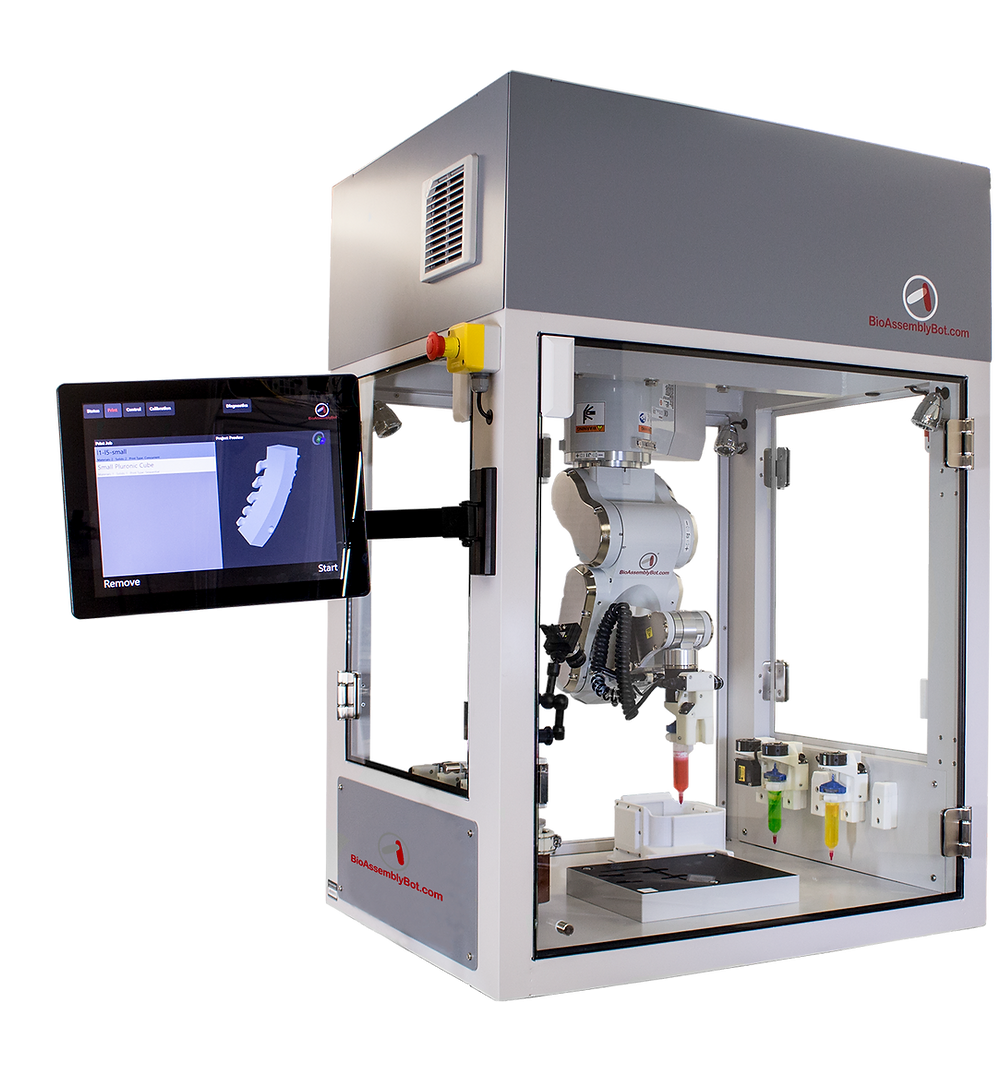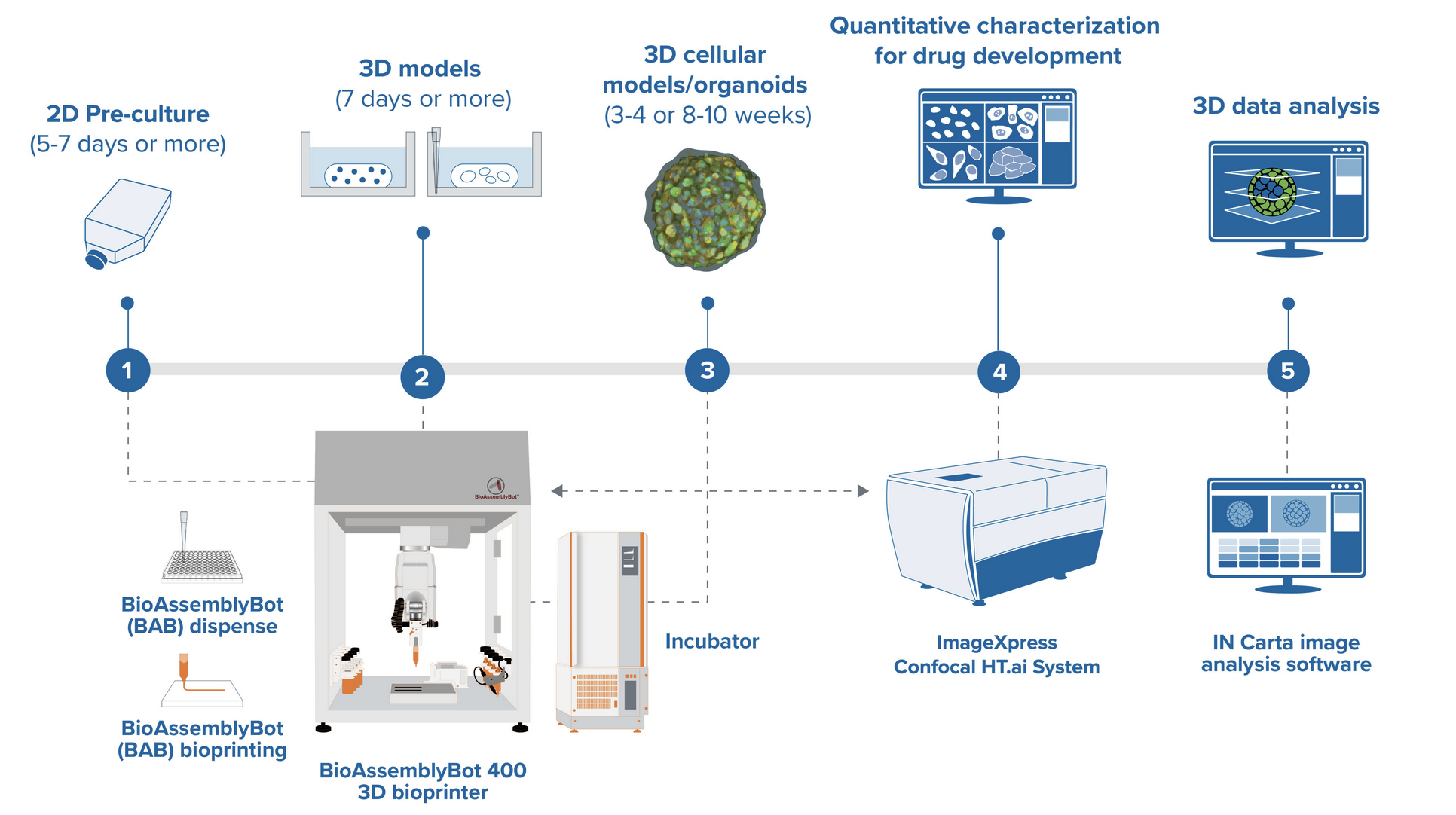Bioprinting Automation for Drug Discovery to Be Developed by Molecular Devices and Advanced Solutions
Molecular Devices, a Silicon Valley manufacturer of laboratory equipment, has partnered with bioprinting company Advanced Solutions Life Sciences to develop 3D biology automation technologies for drug discovery.
As part of the commercial partnership, Molecular Devices will market Advanced Solutions’ bioprinting platform BioAssemblyBot 400 (BAB 400), an intelligent six-axis robotic arm used by life scientists to build 3D model systems with increased throughput and precision, alleviating common concerns associated with manual workflows. Thanks to the new partnership, the BAB 400 includes specific enhancements to Advanced Solutions’ existing bioprinting platform that helps life scientists overcome the challenges of reproducing consistent, complex organoid models at scale for drug development. One of the biggest selling points of the BAB 400 is that it integrates seamlessly with Molecular Devices’ proprietary ImageXpress Confocal HT.ai High-Content Imaging System, creating a fully optimized automation workflow.
 BioAssemblyBot 400 is an intelligent robot life scientists use to build biological structures. Image courtesy of Advanced Solutions.
BioAssemblyBot 400 is an intelligent robot life scientists use to build biological structures. Image courtesy of Advanced Solutions.Designed to help researchers advance phenotypic screening of 3D organoid models, ImageXpress delivers faster image acquisition, and multiplexing flexibility with high-performance lasers, claims the company. The system comes equipped with machine learning image analysis software that follows the history of life sciences solutions and is powered through the brand’s machine learning IN Carta Image Analysis Software to round out the organoid workflow.
Commenting on the potential of the new partnership, Molecular Devices President Susan Murphy indicates that researchers are looking for a better way to develop and screen organoids when manual processes and manual technologies produce mixed results, wasting time and resources. So partnering with innovators like Advanced Solutions addresses these pain points for our customers, she says.
“The ImageXpress cellular imaging systems and BAB 400 deliver an automated, turnkey platform that improves the quality and viability of 3D cell cultures at higher throughput,” added Murphy.
3D cell models like self-organized organoids can speed the drug discovery process and reduce clinical trial failure rates due to their more human, biologically relevant structure. However, they can grow to be highly variable depending on the technology, workflows, and expertise in place, derailing the reliability of endpoint assays.
In a fully automated enclosure, Molecular Devices promises customers that the BAB 400’s six-axis robotic arm uses a wide range of interchangeable BAB hands to systematically reproduce organoids, while the ImageXpress Confocal HT.ai system informs the modeling and screening process with high-content cellular imaging information for increased precision.
 BAB400 integrates seamlessly with Molecular Devices’ ImageXpress Confocal HT.ai to round out the integrated organoid workflow. Image courtesy of Molecular Devices.
BAB400 integrates seamlessly with Molecular Devices’ ImageXpress Confocal HT.ai to round out the integrated organoid workflow. Image courtesy of Molecular Devices.Some of the key advantages of the BAB 400 include the development of new drug targets, improved viability of 3D cell cultures, and improved flexibility with integrated workflows.
Furthermore, according to the companies, the precision of the BAB400’s six-axis robotic arm exceeds human skill to bioprint, pick up biology, and complete complex assays while reducing human error, variability, and cost. Another big benefit of automating the technology is that researchers can add their biomaterials and just press “go,” so BAB will automate countless processes, such as organoid dispensing and bioprinting. Once these processes are complete, the BAB will notify them.
“Pairing the flexible yet controlled nature of BAB 400 with the image quality and speed of the ImageXpress automates high-content, 3D model research in a uniquely integrated and efficient process,” said Michael Golway, President and CEO of Advanced Solutions. “Together, we’re enabling users to quickly design, develop, and image complex organoids like never before. This is expected to improve efficacy and toxicity results, setting more novel therapeutics up for success.”
 Molecular Devices ImageXpress Confocal HT.ai High-Content Imaging System paired with IN Carta Image Analysis Software. Image courtesy of Molecular Devices.
Molecular Devices ImageXpress Confocal HT.ai High-Content Imaging System paired with IN Carta Image Analysis Software. Image courtesy of Molecular Devices.Available to customers in North America and Europe, the BAB 400 and integrated ImageXpress Cellular Imaging Systems are ideal for modern biology and drug discovery labs thanks to their simultaneous, programmable generation and organization of cell types with different origins and functions in artificial tissues that aim to invigorate future biomedical 3D organ and tissue engineering, particularly regenerative therapies, drug screening, and disease modeling. Interested researchers are encouraged to watch this on-demand webinar to learn more about how to advance 3D biology via this turnkey platform.
Originally released in 2015 by Advanced Solutions, the BAB 400 is helping labs worldwide build biological structures. For example, the U.S. Department of Veterans Affairs’ VA Ventures project is working on 3D-printed living bone replacements called BioBone and uses BAB bioprinters to 3D print structures from the patient’s own cells that can be subsequently vascularized into living bones. In France, Professor Christophe Marquette from the University of Lyon‘s biochemistry department is also leveraging the technology to develop novel surgical techniques that incorporates robotics and 3D bioprinting, while Dr. Doris Taylor, CEO of Organamet Bio, is using the BioAssemblyBot to develop a groundbreaking way to engineer personalized hearts using a patient’s own stem cells. Prior to this latest partnership with Molecular Devices, BAB 400 also integrated seamlessly with other lab equipment, like Cytiva’s IN Cell Analyzer, and according to the company, there are plans for more integrations in the future.
Subscribe to Our Email Newsletter
Stay up-to-date on all the latest news from the 3D printing industry and receive information and offers from third party vendors.
You May Also Like
Printing Money Episode 17: Recent 3D Printing Deals, with Alex Kingsbury
Printing Money is back with Episode 17! Our host, NewCap Partners‘ Danny Piper, is joined by Alex Kingsbury for this episode, so you can prepare yourself for smart coverage laced...
Insights from Cantor Fitzgerald on AM’s Q1 2024 Landscape
A recent survey by Cantor Fitzgerald sheds light on the persistent challenges within the additive manufacturing (AM) industry in the first quarter of 2024. Based on responses from 38 industry...
3D Printing Financials: Xometry’s Scaling up and Strong Start to 2024
Xometry (Nasdaq: XMTR) kicked off 2024 with strong results, boosting its marketplace and technology to new heights. Both revenue and gross margin soared, fueled by an expanding global network of...
3D Printing Financials: Desktop Metal Targets Recovery Amid Net Losses and Revenue Downturn
Despite facing a decline in revenue and the persistent challenges of a tight economic climate, Desktop Metal (NYSE: DM) is making strides toward operational efficiency. The first quarter of 2024...
































